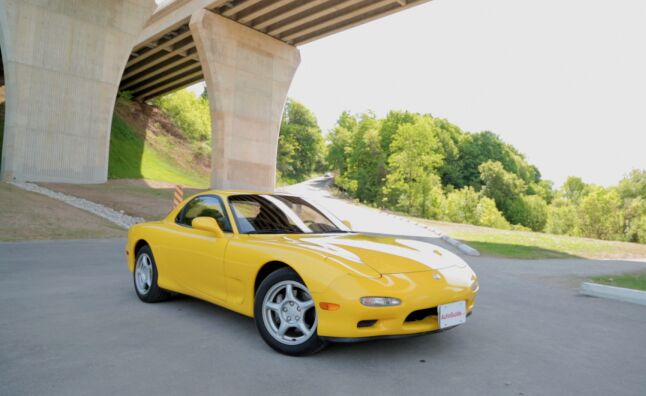Retro Ride: 1993 Mazda RX-7 Review

The 1990s was a great time for Japanese sports cars. Pretty much every manufacturer was building a world class performance machine including Mazda, with the third generation RX-7. But that was twenty years ago and what may have been great then, might not be any good today. So, we have gotten our hands on a pristine, low mileage 1993 Mazda RX-7 to see if it was all hype, or the real deal.
The 1990s is a decade known for things like flannel shirts, grunge music, Barney the purple dinosaur and Napster. But for those who live and breathe high octane fuel, the ‘90s was also a great time for performance vehicles. With the world economy in fine shape, manufacturers everywhere were producing some impressive machinery. This is the decade that gave birth to the Dodge Viper, McLaren F1 and Lamborghini Diablo.
FAST FACTS
1. Power comes from a 1.3 L turbocharged two rotor motor making 255 hp and 217 lb-ft of torque.
2. The RX-7 weighs less than 2,800 lbs.
3. Mazda claims a 0-60 mph time of just 4.9 seconds for the 1993 Mazda RX-7.
But there was one country in particular that was going bat-crazy for performance cars: Japan. Nissan had the 300ZX, Acura the NSX, Toyota the Supra, Mitsubishi the 3000GT and Mazda the RX-7. These cars all became the darling of the tuner community and not many low mileage, bone stock examples are left in existence today. But there are a few, like this bright yellow 1993 Mazda RX-7. With less than 15,000 miles and in nearly the same shape as it was when leaving showroom floors twenty years ago, this car is a virtual time machine.
GAME CHANGING RX-7
Get the Flash Player to see this player.
When the third generation ‘FD’ RX-7 came on the market in 1993, it took Mazda’s little rotary sports car to a whole new level. It had a double-wishbone suspension at all four corners, a sequential turbocharged engine, anti-lock brakes and a torsen limited slip differential.
That really set the third generation model apart from the ones that came before it though was the styling. The gorgeous, flowing body lines told everyone who set eyes on it that this car was serious. Way ahead of its time in the early ‘90s, this RX-7 still looks great 20 years later. The only real give away to the car’s age can be found in the pop-up headlights, taillight design and wheels that look small compared to today’s ‘dubs on everything’ mentality. Yes, the design truly has aged well. I have driven many impressive, expensive, modern cars but nothing has turned more heads than this bright yellow classic.
THE ROTARY: MASTERPIECE OR FAILURE?
While all the other Japanese sports car utilized a V6 of some form, Mazda went a different route; the rotary route. The 1.3-liter two rotor turbocharged motor makes 255 hp and 217 lb-ft of torque. This may not sound like much, but the RX-7 weighs less than 2,800 lbs.; roughly the same as a Scion FR-S. That power-to-weight was good enough for a claimed 0-60 mph time of just 4.9 seconds.
Reliability be damned, the two rotor turbo is a terrific piece of engineering. It is so smooth all the way up to the 8,000 rpm redline, and feels far more torquey in mid and low range rpm than numbers would suggest thanks to the sequential turbochargers. It makes just the right amount of power for the chassis and when rung out, the turbo makes a crazy high pitched whistle. Why can’t they make turbo cars sound like this any more?
BALANCED LIKE THE SCALES OF JUSTICE
But the RX-7 isn’t just about the engine; the chassis is pure mastery as well. With a low center of gravity and a perfect 50:50 front-to-rear weight distribution it’s a thrill to drive.
Being a car of the early ‘90s, there are no electronic safety nets; but not too worry, the power is linear and chassis feels so planted that the car still produces tons of confidence even when powering through a corner. If the car is pushed too hard, the backend will break traction and rotate. A well-balanced machine, it’s controllable, but it can also bite you if you’re not careful.
Luckily, our two-decade old RX-7 came with the correct transmission, the 5-speed manual and not the killjoy 4-speed automatic. Even though it is now 20-years old, the transmission is smoother and more precise than many modern gearboxes on the market. The stick shift just adds to the overall precision of this car.
MISSING MODERN CONVENIENCES
Controlling the car, the hydraulic steering feels great at low to moderate speeds, but unfortunately becomes overly loose at highway speeds. Modern electric power steering has its drawbacks, but it’s easy to see here that is also has its advantages
The car is just so raw, mostly because it comes from an era before road feel was engineered out of vehicles. The downside to this raw feeling is horrible NHV (noise, vibration and harshness) levels. The RX-7 shakes, rattles and crashes over every imperfection on the road surface, no matter how minor.
Inside, the RX-7 is as ‘90s as a Laser Disc. The old, simple controls that operate everything are refreshingly simple; no voice commands, no touch screens, no 100 page manual to change a radio station. Unfortunately, other technologies we’re spoiled by in modern automobiles are missing. There is no way to adjust the steering wheel or height of the driver’s seat which leaves the wheel firmly in the lap of most drivers; a most awkward driving position.
It’s not unlivable though. Behind the front seats are two deep bins that resemble fishing live wells. The driver’s door also features a handy storage area that can hold wallets and keys. Add in the fact the RX-7 is a semi-practical hatchback and this sports car is actually quite reasonable as a regular-use machine, assuming you can live with the jarring ride. Just don’t stop at your favorite coffee shop on the way to the racetrack to grab an oversized cup of Jo; this car has no cup holders.
THE VERDICT
After spending a week in the RX-7, a few things became clear. First, this Mazda proves that modern performance cars don’t need a raucous 400 hp engine if they are as light and well balanced as this car.
The RX-7 really feels like a larger, more powerful Miata, or gives a hint at what a boosted Scion FR-S or Subaru BRZ might feel like. It also makes us wish Mazda would shove the Mazdaspeed3’s turbocharged 4-cylinder in a slightly larger, permanent roof vehicle based on the current Miata and recreate a vehicle like this, as the world can always use more pure sports cars. Sure it wouldn’t have a rotary engine, but look at the plus side; at least it would be reliable.
LOVE IT
- Gorgeous styling
- Great handling
- Good power
- Fun to drive
LEAVE IT
- Harsh ride
- Historically unreliable
- Odd driving position

A 20+ year industry veteran, Mike rejoins the AutoGuide team as the Managing Editor. He started his career at a young age working at dealerships, car rentals, and used car advertisers. He then found his true passion, automotive writing. After contributing to multiple websites for several years, he spent the next six years working at the head office of an automotive OEM, before returning back to the field he loves. He is a member of the Automobile Journalists Association of Canada (AJAC), and Midwest Automotive Media Association (MAMA). He's the recipient of a feature writing of the year award and multiple video of the year awards.
More by Mike Schlee
































Comments
Join the conversation
I know I'd like one, but they seem impossible to find unless they've been tuned to bits. That styling, was by far the best looking car of the period. It's aged extremely well, both exterior and interior, all business, still look appealing.
Wouldve been cool if they made a special edition Renesis powered Miata! This would pretty much be what he described at the end of the video. The nb miataran until 05. the rx8 was available in 04. The nc miata is even built on the rx8 platform!